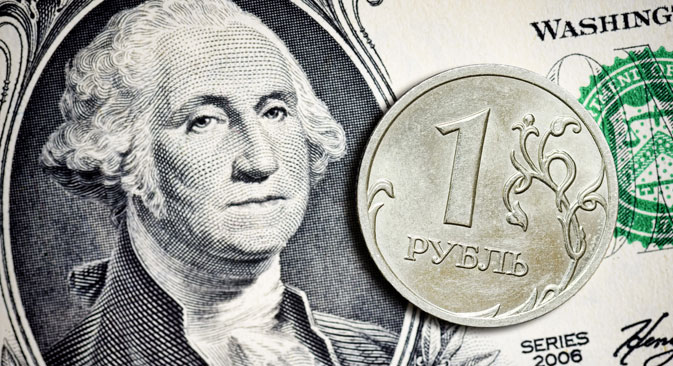
The Central Bank's new practice contradicts the decision on the transition to a free exchange rate for the ruble. Source: DPA / Vostock Photo
Russia’s central bank has begun buying U.S. dollars in order to replenish its foreign-exchange reserves, the regulator’s press service has reported.
So far the purchases have amounted to relatively small sums of up to $100-200 million per day. On May 13, for example, the Central Bank purchased $181 million, and on May 14 – $200 million.
However, by international standards, Russia has ample foreign reserves and is among the top 10 countries with an acceptable "currency cushion," which allows to provide the critical volume of imports and to service the foreign debt, said Alla Dvoretskaya, a professor of the Faculty of Social and Economic Sciences at the Russian Presidential Academy of National Economy and Public Administration.
According to Dvoretskaya, buying up currency is an attempt to counter the risk of the excessive strengthening of the ruble.
However, Dmitry Bedenkov, head of the analytical department at Russ-Invest, said that in this case the regulator's plans should be seen as an element of merely verbal intervention: The Central Bank is making it clear to the market that it is not interested in strengthening the ruble.
"Given the fact that the daily currency trading amounts to about $5 billion, the purchase volume at $100-200 million in general should not have a significant impact on the dynamics of the currency market," said Bedenkov.
As Dvoretskaya explained, the market is benefiting from “foreign policy stabilization,” accompanied by a calmer oil market, with fewer drastic fluctuations in prices.
“Combined with interventions, this has supported the ruble so much that imports have started to enliven again, which inhibits economic growth and import substitution from domestic sources," she said.
At the same time the strengthening ruble is threatening the interests of exporters, especially of raw materials, and, consequently, the budget is suffering, since oil and gas revenues account for more than 50 percent of the federal budget.
According to UFS IC principal analyst Ilya Balakirev, the resurgent ruble has “a number of unpleasant consequences” for the economy.
“For export-oriented companies, the cheap ruble is profitable. This is doubly true for the companies that export not raw materials but products with high added value," said Balakirev.
Moreover, according to Balakirev, the prices of products in world markets, including in the metallurgy sphere, are at long-term lows, and with a strong ruble, metals exporters will be in even more dire straits.
The Central Bank's new practice contradicts the decision on the transition to a free exchange rate for the ruble. "The official resumption of regular purchases of foreign currency on the domestic market is, at first glance, a step backwards in the implementation of the Bank of Russia's declared transition to a free-floating ruble," said Dvoretskaya.
According to her, at the beginning of 2014, targeted foreign exchange interventions were discontinued, and by the end of the year, the Central Bank attempted to exit the market altogether, which dramatically brought down the ruble, weakened under the influence of macro-economic and geopolitical factors.
"Therefore, the Bank of Russia reserved the right to intervene in the situation by irregular and sudden interventions only in case of threats to financial stability," said Dvoretskaya.
Nevertheless, according to Dvoretskaya, being bearish on the ruble should be a tactical step; strategically, it is important to focus on strengthening the credibility of the national currency, its competitiveness and purchasing power.
Balakirev, meanwhile, said that the Central Bank’s decision to take action against the strengthening of the ruble sends an important signal to the market.
"When the Central Bank tried to deal with the collapse of the ruble in the second half of 2014, it spent several billion a day – and it did not help much. This is an important signal that will calm down currency speculators," he said.
According to Balakirev, if these signals from the regulator are systematic and clear, they will have a better impact on the market than actual currency purchases.
All rights reserved by Rossiyskaya Gazeta.
Subscribe
to our newsletter!
Get the week's best stories straight to your inbox